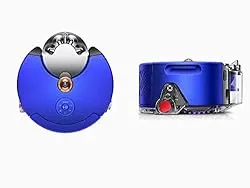Best Robot Vacuum Cleaners for Google Home
Robot vacuum cleaners continue to get smarter with each generation and now you can even control them with your voice thanks to a growing range of robot vacuum cleaners that work with Google Home smart speakers and other Google Assistant devices.
I’ve been reviewing and comparing the best robot vacuums from all price levels to find out which ones work best with Google Home whilst still providing a high cleaning performance. I’ve shared all of my recommended devices in this guide.
Table Of Contents
Using Robot Vacuums and Google Home
Why would you want a Google Home-compatible robot vacuum? Well, here are some of the things you can now do with your voices thanks to Google Home integration (varies by device):
- Start/stop cleaning
- Send the vacuum back to its dock
- Get a status update
- Find your robot vacuum
- Instruct robot vacuum to clean a certain room/zone
You aren’t just limited to Google Home smart speakers either, you can use any device with Google Assistant to control your robot vacuum, this includes Nest Hub devices, Android TV’s, Chromecasts with Google TV, Lenovo smart displays, and more.
Best Robot Vacuums for Google Home
Here are my top recommended robot vacuums for Google Home:
- Best Overall: Roborock S6 Pure
- Runner Up: Roomba 960
- Budget Pick: Eufy 15C MAX
- Best Self-Emptying: Roomba i7+
- Best for Hard Floors: Ecovacs N79S
- Best for Deep Clean: Dyson Heurist
Keep reading for my full reviews of each recommendation and a breakdown of how each can be used with Google Home.
Best Overall: Roborock S6 Pure
Accurately maps your home using lasers
Room-by-room cleaning using Google Home voice commands
Can switch between vacuuming and mopping by itself
App not overly user-friendly
Smaller dustbin than the S6 MAX V
There are only a few Roborock’s that currently work with Google Home, naturally, the top-of-the-range Roborock S6 Pure is my top pick. It’s the cheapest of the S6 line-up, but still has all the intelligence and good cleaning performance.
It has excellent navigation using Lidar that maps your home and creates floor plans. In the Xiaomi Home app, you can customise these plans by naming each room for room-by-room cleaning. The app isn’t very user-friendly so it may take a while to learn where all the settings are.
All of the Roborock S6 range are compatible with Google Home. Using voice commands, you can start/stop your Roborock, send it back to the base for charging or check the status.
If you’ve set up names for your rooms in the Roborock app, thanks to a recent update you can also use Google Home to instruct your Roborock to clean specific rooms by saying “Hey Google, clean the living room”.
The vacuum does have mopping functions with a built-in water tank. It can switch between vacuuming and mopping without any manual interaction, although be sure to set up no-vacuum or no-mop zones beforehand else you might get wet carpets.
Compared to the more premium S6 MAX V, the S6 Pure has a reduced suction power of 2,000pA (still well above average), a smaller dust bin, and lower quality bristles. I think these are fair compromises for the price difference.
Runner Up: Roomba 960

Takes a logical route for a quicker clean
Dual rubber rollers are great for pet hair
Dirt detect allows it to circle back over dirty areas
No mapping or room-by-room cleaning
Next up, I recommend Roomba’s 960 series, shown here is the basic model in the series, the 960.
This model is excellent for picking up pet hair thanks to the patented dual roller design that is only found on Roomba’s. It also has a rubber roller as opposed to traditional bristles, which doesn’t trap hair and is easier to clean.
The 960 series doesn’t provide a floorplan in the iRobot Home app like some of the top tier Roomba’s, however, it has Roomba’s iadapt 2.0 navigation that allows it to clean your home in straight lines with near-perfect coverage of both small and big rooms, usually in a faster time than other devices too.
It has a feature called Dirt Detect which can identify areas that are particularly dirty and circle back over them a few times. As with all of Roomba’s smart navigation robots, it also has recharge-and-resume, so despite a below-average 75-minute runtime, it can head back to the dock for to recharge and carry on the cycle where it left off.
The 960 series has integration with Google Home that allows you to start/stop the vacuum, check the status, locate it in your home and send it back to the dock, all using your voice.
Read my integration guide to find out more about using Roomba with Google Home.
Best Value: Eufy 15C MAX

Affordable price
BoostIQ adapts suction power depending upon the floor type
Basic Google Home integration
Smart navigation in logical straight lines
No mapping or room-by-room cleaning
No recharge-and-resume
If you’re looking for quality on a budget, Eufy’s Robovac is the go-to brand. It has 2,000pA of suction power which is well above average, and their BoostIQ changes the suction power according to the floor type.
The 15C MAX is one of their lower-priced robot vacuums with Wi-Fi connectivity. Once you’ve connected it up, you can ask Google to start/stop cleaning, to find the vacuum cleaner if you’ve lost it, or to send it back to the dock.
As the Eufy Robovac doesn’t have any mapping ability, the integration with Google Home is a bit more limited so there is no room-by-room cleaning.
Despite the fact it doesn’t create a floor plan, it is still able to navigate in a logical pattern rather than the random path method used by other similarly priced devices, this means you’ll still get good coverage of your home.
There is no recharge-and-resume, so the robot must complete the clean within 100 minutes of battery runtime, this makes it suitable for small-medium size homes. The 600ml dust bin is also above average.
Best Self-Emptying: Roomba I7+
Great for deep cleaning carpets
Self-emptying base requires less frequent intervention
Instruct the Roomba to clean certain rooms/zones using Google Home
Most expensive
The i7+ is one of Roomba’s newest robot vacuums, notable for its floor mapping capability, excellent cleaning performance, and the self-emptying base.
Unlike the Roomba 960 shared earlier, the i7+ has iadapt 3.0 imprint smart mapping technology, this allows it to create a floor plan of your home for room-by-room cleaning schedules and detailed cleaning reports.
Once the map has been created you can also use this to segment rooms, create zones and even note specific objects. Using these labels, you can use Google Home to instruct the vacuum where to clean. For example, you could say “Okay Google, start vacuuming under the kitchen table” after spilling your dinner.
If you have multiple vacuums for various floors in your home, each can have a name to make the Google Assistant commands clearer. The i7+ can work in tandem with iRobot’s Braava M7 mop to coordinate vacuum and mopping.
The standout feature of the i7+ is the clean base (Roomba’s self-emptying base). When the onboard bin is full, the base will suck the dirt out into the larger bin that doesn’t require emptying as often.
Like the Roomba 960, this device also has recharge-and-resume, Dirt Detect, and similar battery life. However, its suction power is about double that of the 960, so it excels at deep cleaning and could replace an upright vacuum altogether.
Note: the device is also available without the clean base, simply called the i7.
Best for Hard Floors: Ecovacs N79S

Great value for money due to being a few years old
Excellent on hard floors thanks to low rubber guard
Great at getting particles from crevices
No mapping or room-by-room cleaning
Cannot set no-go zones for mopping
The Ecovacs N79S was launched back in 2018 but is still a great pick and thanks to ongoing software updates that have helped it keep up with voice assistants. The vacuum is very affordable, and its cleaning abilities are great, particularly when it comes to hard floors or low pile carpets.
The front brushes are capable of sweeping up particles of all sizes, although the brush is prone to getting hairs so you should plan to regularly clean this. On hard floors, the low rubber guard gives it a good seal which means it picks up well from crevices between floorboards.
It has a built-in HEPA filter that captures 99.5% of allergens including pet hair, mould, and dust, and it’s great at edges compared to other devices at this price point.
The N79S has basic Google Home integration thanks to the dedicated Google assistant app Ecovacs built. You can ask Google to start/stop cleaning, pause/resume, send the vacuum back to the dock, or check if it’s on charge.
It doesn’t have any onboard mapping so uses random path navigation; this means it bounces around your home until it deems to have covered the entire floor. This takes longer than a smart navigation robot, but luckily it has an above-average battery capacity of 2600mAh which gives it 100 minutes of runtime.
The vacuum does have mopping abilities; however, you’ll need to manually switch out the 520ml dustbin for a 300ml water tank. As you cannot set no-go zones, the mopping function isn’t suitable if you have both carpets and hard floor.
Best for Deep Clean: Dyson Heurist

Excellent deep cleaning thanks to Dyson cyclone technology
Room-by-room mapping and scheduling
Ring of LED lights helps it perform in dark rooms or at night
Slim width helps it navigate between tables and chairs
Expensive
Cannot yet control room-by-room cleaning with Google Home
Dyson’s 360 Heurist robot vacuum uses their patented cyclone technology that has made them a name in upright vacuums. This mean’s it provides a very thorough clean and can pick up small and large debris.
The Dyson is more expensive than most others here, but this can viably replace a normal vacuum cleaner, providing you don’t have stairs.
The vacuum is good at getting around and navigating over thresholds thanks to tank-style wheels, and its body is much narrower than any other vacuum so it can weave between objects like chair legs, although this does come at the expense of being quite tall.
It uses visual cameras (vSLAM) for navigation like the Roomba’s shared before, however, it has a ring of LED lights on top to help it clean at night and in darker areas of your home where vSLAM normally struggles.
Dyson only added Google Assistant support in late 2020, so the actual commands you can use are quite limited at the moment with basic start/stop commands and the ability to send it back to the dock.
Given that other voice assistants allow you to change modes and ask for a status update, I hope these features are on the way to Google Home.
Room-by-room cleaning is available using the Dyson, however, you cannot currently ask Google Assistant for this and will need to use the Dyson app.